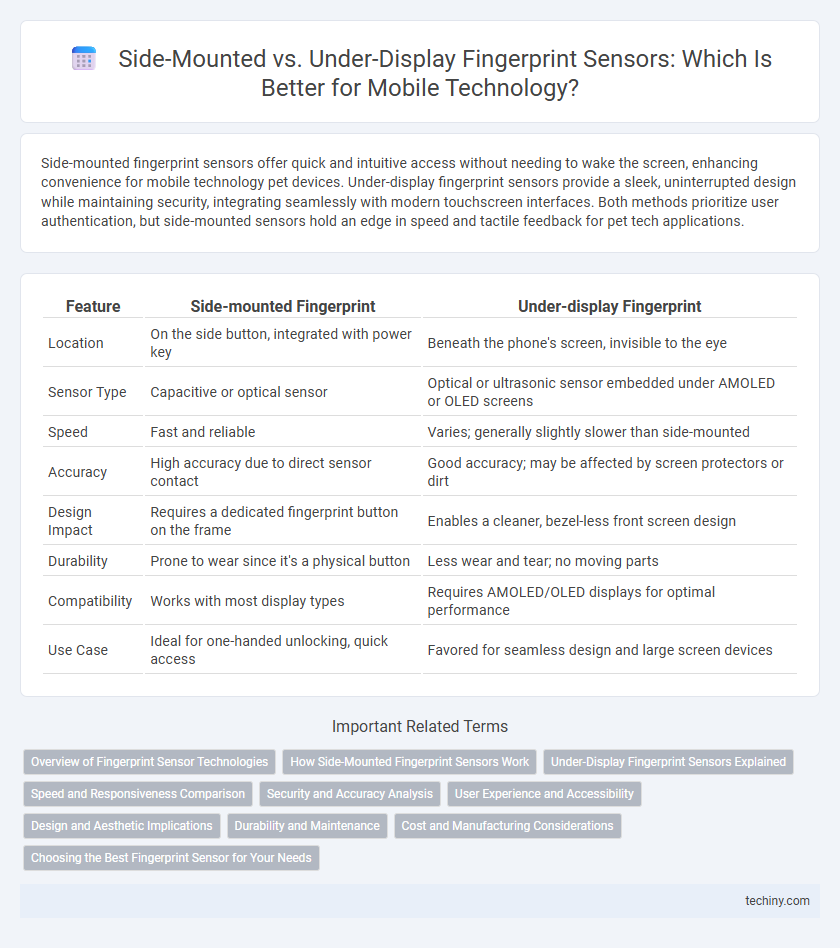Side-mounted fingerprint sensors offer quick and intuitive access without needing to wake the screen, enhancing convenience for mobile technology pet devices. Under-display fingerprint sensors provide a sleek, uninterrupted design while maintaining security, integrating seamlessly with modern touchscreen interfaces. Both methods prioritize user authentication, but side-mounted sensors hold an edge in speed and tactile feedback for pet tech applications.
Table of Comparison
| Feature | Side-mounted Fingerprint | Under-display Fingerprint |
|---|---|---|
| Location | On the side button, integrated with power key | Beneath the phone's screen, invisible to the eye |
| Sensor Type | Capacitive or optical sensor | Optical or ultrasonic sensor embedded under AMOLED or OLED screens |
| Speed | Fast and reliable | Varies; generally slightly slower than side-mounted |
| Accuracy | High accuracy due to direct sensor contact | Good accuracy; may be affected by screen protectors or dirt |
| Design Impact | Requires a dedicated fingerprint button on the frame | Enables a cleaner, bezel-less front screen design |
| Durability | Prone to wear since it's a physical button | Less wear and tear; no moving parts |
| Compatibility | Works with most display types | Requires AMOLED/OLED displays for optimal performance |
| Use Case | Ideal for one-handed unlocking, quick access | Favored for seamless design and large screen devices |
Overview of Fingerprint Sensor Technologies
Side-mounted fingerprint sensors use capacitive or ultrasonic technology embedded in the device's power button, providing quick and ergonomic biometric authentication. Under-display fingerprint sensors, typically optical or ultrasonic, allow seamless integration beneath OLED or AMOLED screens, enabling a larger display area without physical sensors. Both technologies offer secure, fast unlocking methods but differ in placement, speed, and user interaction preferences.
How Side-Mounted Fingerprint Sensors Work
Side-mounted fingerprint sensors use capacitive technology to capture an image of the fingerprint by detecting the unique ridge patterns on the skin's surface. Positioned on the phone's power button or edge, these sensors quickly authenticate users by scanning the fingerprint when the button is pressed or touched. Their placement allows for ergonomic unlocking while maintaining device thinness and power efficiency compared to under-display alternatives.
Under-Display Fingerprint Sensors Explained
Under-display fingerprint sensors utilize optical or ultrasonic technology to read fingerprints through the smartphone's screen, offering a seamless and modern design without compromising device aesthetics. Unlike side-mounted sensors that require physical buttons, under-display sensors enable larger display areas and preserve device sleekness. This technology enhances security by integrating biometric authentication directly into the touchscreen, providing fast and accurate unlocking.
Speed and Responsiveness Comparison
Side-mounted fingerprint sensors typically offer faster unlocking speeds and more immediate responsiveness due to their direct capacitive scanning technology, allowing instant detection with minimal delay. Under-display fingerprint sensors, while offering sleek aesthetics, generally exhibit slightly slower response times as they rely on optical or ultrasonic scanning beneath the screen, which requires additional processing. Advances in ultrasonic technology are narrowing this speed gap, but side-mounted sensors remain the preferred choice for users prioritizing rapid and reliable fingerprint recognition in mobile devices.
Security and Accuracy Analysis
Side-mounted fingerprint sensors offer enhanced security by utilizing capacitive touch technology that accurately reads fingerprint ridges, reducing false acceptance rates compared to optical under-display sensors. Under-display fingerprint sensors, especially ultrasonic variants, provide improved accuracy in diverse lighting and moisture conditions but may be susceptible to spoofing without advanced liveness detection. Security analysis reveals side-mounted sensors benefit from physical button integration, which minimizes sensor tampering, while under-display sensors prioritize seamless design with ongoing improvements in sensor depth resolution and anti-spoofing algorithms.
User Experience and Accessibility
Side-mounted fingerprint sensors offer faster and more natural access, especially for one-handed use, enhancing overall user experience through ergonomic placement. Under-display fingerprint sensors provide a seamless design and larger sensor area but may have slower recognition speeds and reduced accuracy in certain lighting conditions. Accessibility benefits vary as side-mounted sensors accommodate quick verification with tactile feedback, while under-display sensors support a cleaner interface but can challenge users with wet or dirty fingers.
Design and Aesthetic Implications
Side-mounted fingerprint sensors offer a compact, unobtrusive design that maintains device symmetry and provides natural thumb placement, enhancing ergonomic appeal. Under-display fingerprint sensors contribute to sleek, minimalist aesthetics by eliminating physical buttons on the surface, enabling edge-to-edge screen designs and seamless front glass integration. Both technologies influence smartphone form factor evolution, balancing user experience with visual refinement and modern design trends.
Durability and Maintenance
Side-mounted fingerprint sensors offer enhanced durability due to their physical button construction, reducing vulnerabilities to screen damage and maintaining consistent performance over time. Under-display fingerprint sensors, while offering a sleek and seamless design, are more susceptible to wear from frequent screen contact and may require software recalibration to maintain accuracy. Maintenance for side-mounted sensors typically involves less frequent servicing compared to under-display variants, which can degrade with scratches and screen replacements.
Cost and Manufacturing Considerations
Side-mounted fingerprint sensors generally offer lower manufacturing costs due to simpler integration and fewer material requirements compared to under-display sensors. Under-display fingerprint technology demands advanced OLED displays and complex sensor layering, increasing production expenses and time. Cost efficiency considerations often drive manufacturers to choose side-mounted sensors for mid-range devices, while flagship models prioritize under-display solutions despite higher costs.
Choosing the Best Fingerprint Sensor for Your Needs
Side-mounted fingerprint sensors offer quick and easy access, particularly for one-handed use, making them ideal for users prioritizing speed and convenience. Under-display fingerprint sensors provide a sleek, modern design while maintaining screen real estate, appealing to those who value aesthetics and immersive displays. Consider factors like device design, security level, and user comfort to select the fingerprint sensor that best aligns with your preferences and usage habits.
Side-mounted fingerprint vs under-display fingerprint Infographic

 techiny.com
techiny.com